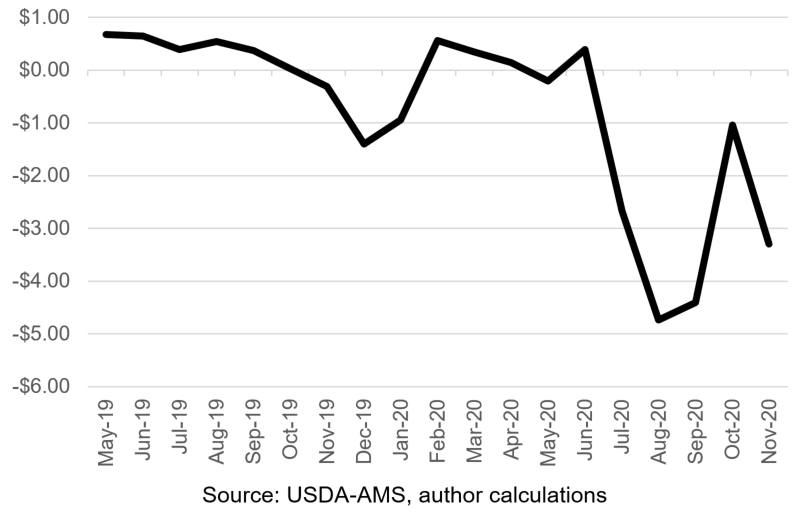Class I Pricing Continues to be a Major Challenge for Kentucky Dairy Producers
Class I Pricing Continues to be a Major Challenge for Kentucky Dairy Producers

When it comes to dairy policy, the headliner from the 2018 farm bill was the Dairy Margin Coverage (DMC) program, which replaced the Margin Protection Program (MPP) from the 2014 farm bill. Another change got much less attention, but has turned out to be extremely impactful over the last several months. A modification to the way that the base class I skim milk price was calculated has left many producers seeing much lower prices than they would have seen under the previous farm bill. This article will quickly review this change and describe how impactful it has been during 2020.
Historically, the base class I skim milk price was the higher of the advanced class III and advanced class IV skim milk pricing factors. In the 2018 farm bill, this was modified to be calculated as the average of the advanced class III and class IV skim milk pricing factors, plus $0.74 per cwt. Put simply, if the difference between the advanced class III and IV skim milk pricing factors was less than $1.48 per cwt, the new formula would return a higher base class I skim price. If that difference was greater than $1.48, the previous formula would yield a higher price. Upon seeing this last spring, I quickly ran a historical comparison and found that this change would have had very little impact had it been in place from 2010 to 2018. During that 9 year period, the new formula would have actually netted a $0.05 per cwt higher class I base skim milk price than the old formula.
The formula in the 2018 farm bill was purposely designed to yield a class I price that was almost the same as the old formula, on average. But like so many things, 2020 has been a very different story as COVID impacted markets. Cheese prices, which are included under class III, have been extremely volatile. After initially falling in April, cheese price more than doubled by June and July, pulled back substantially in August, but rallied again in September. That type of volatility just hasn’t been seen in other markets so it created an unusually large difference between class III and IV prices for much of the year.
Figure 1 probably tells this story best as it shows the advanced class III and IV skim milk prices over the last 5 years (January 2016 to present). For much of 2016-2019, the two price series largely moved together with large differences being uncommon and relatively short-lived, and class III generally carrying a premium to class IV. However, the divergence that has occurred in 2020 is glaring as the advanced class III skim price exceeded class IV by more than $10 per cwt in August and September and has averaged more $4 higher for the first eleven months of 2020 (advanced prices for December will not be available until November).
Figure 1. Advanced Class III and IV Skim Milk Prices 2016-2020 ($ per cwt)

Under the previous pricing system, the higher of these advanced pricing factors would become the base class I skim milk price, so this type of divergence between the two was less problematic. However, under the new formula that took effect in May of 2019, the impact on the class I skim milk base is very significant. Figure 2 tracks the difference between the base class I skim milk price, under the old and new formulas, for the 19 months since the change took effect. Specifically, it shows the new formula minus the old formula, so when values below $0 are shown, that implies how much lower the base class I skim milk price is under the new formula. On average, under the new formula, the base class I skim milk price has been $3.23 lower July through November of 2020.
Figure 2. Impact of New Class I Skim Milk Price Calculation May 2019 to November 2020 ($ per cwt)

This base class I skim milk price is the starting point for valuing class I milk for the month. While this impacts most all dairy producers to some extent, the impact is the largest in areas where a larger share of milk is sold as class I (fluid). Because Kentucky is a milk-deficit area, a very large share of our milk is sold as class I. For most months, class I utilization in our region is around 70%. While there is no way to know how long this wide disparity between class III and class IV prices will persist, there is no question that it is negatively impacting dairy producer milk checks in the Commonwealth.
Author(s) Contact Information:
Dr. Kenny Burdine | kburdine@uky.edu
Dr. David Anderson | Professor and Extension Economis | Texas A & M University | danderson@tamu.edu
